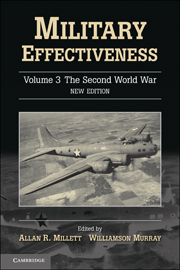Book contents
- Frontmatter
- Contents
- List of Contributors
- Introduction: Military Effectiveness Twenty Years After
- Maps
- 1 The Effectiveness of the Japanese Military Establishment in the Second World War
- 2 The United States Armed Forces in the Second World War
- 3 British Military Effectiveness in the Second World War
- 4 The Italian Armed Forces, 1940–3
- 5 The Dynamics of Volksgemeinschaft: The Effectiveness of the German Military Establishment in the Second World War
- 6 Bitter Victory: French Military Effectiveness during the Second World War
- 7 The Soviet Armed Forces in the Great Patriotic War, 1941–5
- 8 Military Effectiveness in the Second World War
- 9 Challenge and Response at the Operation and Tactical Levels, 1914–45
- 10 The Political and Strategic Dimensions of Military Effectiveness
- Index
8 - Military Effectiveness in the Second World War
Published online by Cambridge University Press: 05 June 2012
- Frontmatter
- Contents
- List of Contributors
- Introduction: Military Effectiveness Twenty Years After
- Maps
- 1 The Effectiveness of the Japanese Military Establishment in the Second World War
- 2 The United States Armed Forces in the Second World War
- 3 British Military Effectiveness in the Second World War
- 4 The Italian Armed Forces, 1940–3
- 5 The Dynamics of Volksgemeinschaft: The Effectiveness of the German Military Establishment in the Second World War
- 6 Bitter Victory: French Military Effectiveness during the Second World War
- 7 The Soviet Armed Forces in the Great Patriotic War, 1941–5
- 8 Military Effectiveness in the Second World War
- 9 Challenge and Response at the Operation and Tactical Levels, 1914–45
- 10 The Political and Strategic Dimensions of Military Effectiveness
- Index
Summary
Introduction
The Second World War was perceived as a moral and ideological conflict. The anti-Axis coalition regarded it as a defense of freedom and democracy. The Axis powers saw it as a racially and culturally dictated struggle for national self-fulfillment. Each side proclaimed a firm dedication to commonly held principles in the abstract and left its members free to construe them according to their own lights. In their announced war aims, the governments on both sides committed themselves to crusades: the United States, Britain, and the Soviet Union against fascism and militarism; Germany and its allies against communism; Japan against colonialism. The sense of a righteous cause and the promise of a ‘brave new world’ to follow figured significantly in the military effectiveness of the Axis armed forces as well as those of their opponents – and in the ruthlessness with which the war was fought.
The still prevailing view that the war was just and necessary has tended to obscure its more fundamental and pervasive character as a continuation, an updated re-enactment, of the First World War. The political division was essentially the same: Britain, France, Russia, and the United States against Germany, with Japan and Italy, as they had in the first war, following their pure self-interest. Although the war was thought of as global, the decisive theater was in Europe, and there the predominant strategic problem for both sides was again a two-front war. The Second World War was fought with the same weapons and technology as had been employed in the first war.
- Type
- Chapter
- Information
- Military Effectiveness , pp. 277 - 319Publisher: Cambridge University PressPrint publication year: 2010
- 1
- Cited by



